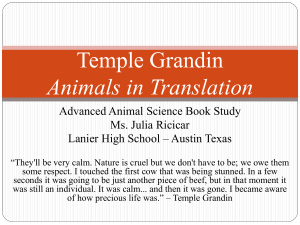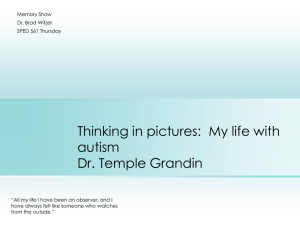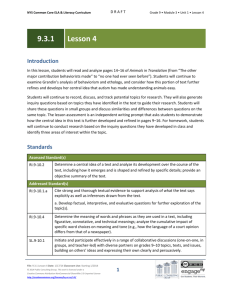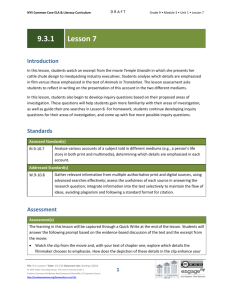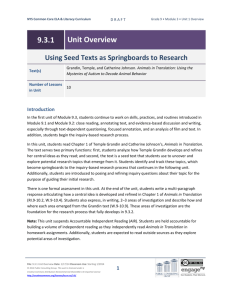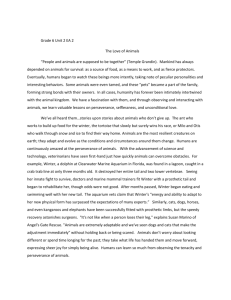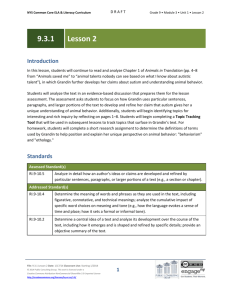Learning Sequence
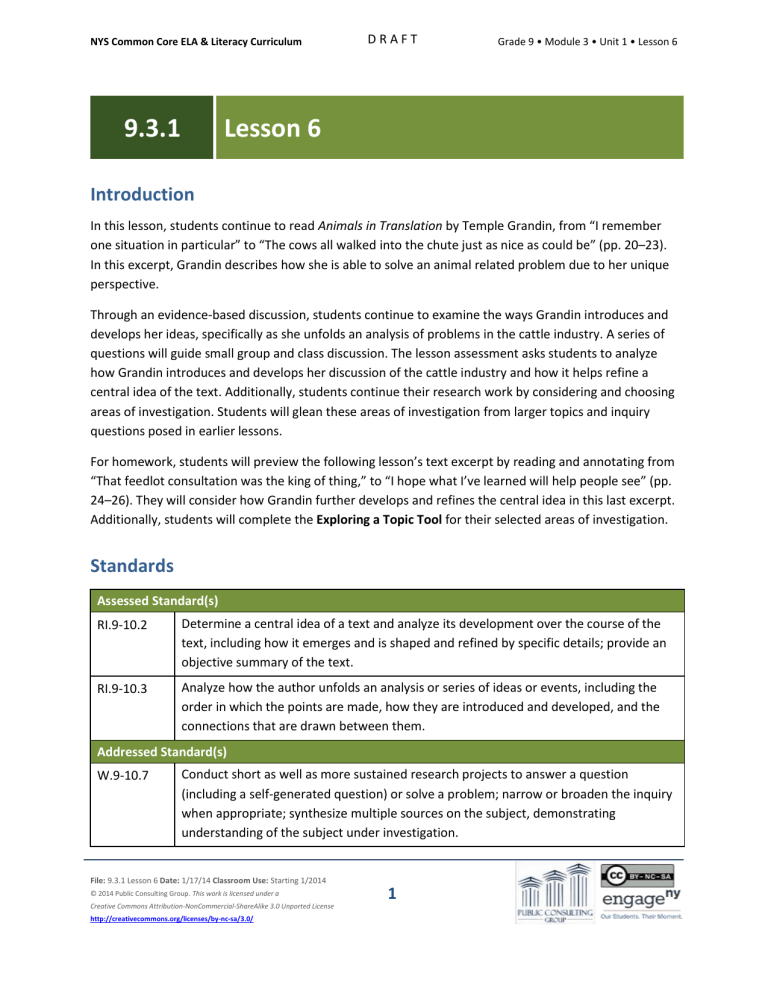
NYS Common Core ELA & Literacy Curriculum
9.3.1 Lesson 6
D R A F T
Grade 9 • Module 3 • Unit 1 • Lesson 6
Introduction
In this lesson, students continue to read Animals in Translation by Temple Grandin, from “I remember one situation in particular” to “The cows all walked into the chute just as nice as could be” (pp. 20–23).
In this excerpt, Grandin describes how she is able to solve an animal related problem due to her unique perspective.
Through an evidence-based discussion, students continue to examine the ways Grandin introduces and develops her ideas, specifically as she unfolds an analysis of problems in the cattle industry. A series of questions will guide small group and class discussion. The lesson assessment asks students to analyze how Grandin introduces and develops her discussion of the cattle industry and how it helps refine a central idea of the text. Additionally, students continue their research work by considering and choosing areas of investigation. Students will glean these areas of investigation from larger topics and inquiry questions posed in earlier lessons.
For homework, students will preview the following lesson’s text excerpt by reading and annotating from
“That feedlot consultation was the king of thing,” to “I hope what I’ve learned will help people see” (pp.
24–26). They will consider how Grandin further develops and refines the central idea in this last excerpt.
Additionally, students will complete the Exploring a Topic Tool for their selected areas of investigation.
Standards
Assessed Standard(s)
RI.9-10.2 Determine a central idea of a text and analyze its development over the course of the text, including how it emerges and is shaped and refined by specific details; provide an objective summary of the text.
RI.9-10.3 Analyze how the author unfolds an analysis or series of ideas or events, including the order in which the points are made, how they are introduced and developed, and the connections that are drawn between them.
Addressed Standard(s)
W.9-10.7 Conduct short as well as more sustained research projects to answer a question
(including a self-generated question) or solve a problem; narrow or broaden the inquiry when appropriate; synthesize multiple sources on the subject, demonstrating understanding of the subject under investigation.
File: 9.3.1 Lesson 6 Date: 1/17/14 Classroom Use: Starting 1/2014
© 2014 Public Consulting Group. This work is licensed under a
Creative Commons Attribution-NonCommercial-ShareAlike 3.0 Unported License http://creativecommons.org/licenses/by-nc-sa/3.0/
1
NYS Common Core ELA & Literacy Curriculum
D R A F T
Grade 9 • Module 3 • Unit 1 • Lesson 6
Assessment
Assessment(s)
The learning in this lesson will be captured through a Quick Write at the end of the lesson. Students will answer the following prompt based on the evidence-based discussion conducted in the lesson.
How does Grandin introduce and develop her discussion of the cattle industry? How does this discussion develop and refine a central idea of the text?
This assessment will be evaluated using the Short Response Rubric.
High Performance Response(s)
A high performance response may include the following:
Grandin introduces a problem that an owner of a “cattle-handling facility” encountered. The cattle refused to “walk into a squeeze chute.” Grandin explains that neither the chute nor the shots bother the cows. Something else caused the problem. And since vaccinations of cattle are essential, the owner, according to Grandin, “was starting to panic” (p. 20). The reason for the panic was the greater problem; the consequences of the situation would lead to lack of income. Grandin explains how her unique skills, due to her autism, helped her solve the problem. In order to figure out what was wrong with the animals, people must “try to see what the animal is seeing” (p. 23).
Once she did that she identified what was wrong and she offered an immediate, successful solution.
Vocabulary
Vocabulary to provide directly (will not include extended instruction)
None.
Vocabulary to teach (may include direct word work and/or questions)
cower (v.) – to crouch in fear
ambiguity (n.) – uncertainty or inexactness of meaning in language
File: 9.3.1 Lesson 6 Date: 1/17/14 Classroom Use: Starting 1/2014
© 2014 Public Consulting Group. This work is licensed under a
Creative Commons Attribution-NonCommercial-ShareAlike 3.0 Unported License http://creativecommons.org/licenses/by-nc-sa/3.0/
2
NYS Common Core ELA & Literacy Curriculum
D R A F T
Lesson Agenda/Overview
Student-Facing Agenda
Standards & Text:
Standards: RI.9-10.2, RI.9-10.3, W.9-10.7
Text: Animals in Translation, by Temple Grandin (pp. 20–23).
Learning Sequence:
1.
Introduction of Lesson Agenda
2.
Homework Accountability
3.
Pages 20–23 Reading and Discussion
4.
Areas of Investigation
5.
Quick Write
6.
Closing
Grade 9 • Module 3 • Unit 1 • Lesson 6
% of Lesson
1.
5%
2.
15%
3.
35%
4.
30%
5.
10%
6.
5%
Materials
Student copies of the 9.3 Common Core Learning Standards Tool (refer to 9.3.1 Lesson 1)
Student copies of the Topic Tracking Tool (refer to 9.3.1 Lesson 2)
Copies of the Exploring A Topic Tool for each student
Student copies of the Short Response Rubric and Checklist (refer to 9.3.1 Lesson 1)
Learning Sequence
How to Use the Learning Sequence
Symbol Type of Text & Interpretation of the Symbol
10% Percentage indicates the percentage of lesson time each activity should take.
Plain text indicates teacher action. no symbol
Bold text indicates questions for the teacher to ask students.
Italicized text indicates a vocabulary word.
Indicates student action(s).
Indicates possible student response(s) to teacher questions.
Indicates instructional notes for the teacher.
File: 9.3.1 Lesson 6 Date: 1/17/14 Classroom Use: Starting 1/2014
© 2014 Public Consulting Group. This work is licensed under a
Creative Commons Attribution-NonCommercial-ShareAlike 3.0 Unported License http://creativecommons.org/licenses/by-nc-sa/3.0/
3
NYS Common Core ELA & Literacy Curriculum
D R A F T
Grade 9 • Module 3 • Unit 1 • Lesson 6
Activity 1: Introduction of Lesson Agenda 5%
Begin by reviewing the agenda and the assessed standards for this lesson: RI.9-10.2 and RI.9-10.3.
Explain that in this lesson, students continue to use evidence-based discussion to examine the ways
Grandin introduces and develops her ideas, specifically as she unfolds an analysis of problems in the cattle industry. Additionally, students continue their research work by considering and choosing areas of investigation. These areas of investigation will be gleaned from the larger topics and inquiry questions students have posed in the previous lessons. The lesson concludes with a Quick Write.
Students look at the agenda.
Activity 2: Homework Accountability 15%
Instruct students to form pairs and share their annotation from pages 20–23.
In pairs, students share annotations from pages 20–23.
Ask student volunteers to briefly share out some of their annotations.
Student annotations may include the following: o Boxes around the words: cower, dwarfism o Underline the sentence: “Thinking about a shot makes it worse.”– an interesting observation that humans feel more pain because they think about the shot o Star near “pneumonia” – Animals get the same diseases as people. This could lead to a possible topic. o Star near “prods” – Doesn’t seem right, but what else can they do? o Star near several references to “stress” – This whole idea of stress among animals and people and the physical impact seems interesting. o Exclamation point near “They were afraid to walk into pitch-black space.” o Star near “try to see what the animal is seeing.”
Ask student pairs to now share two of the inquiry questions they developed and refined for homework.
Students should identify the topic that the inquiry questions address.
Students share two of their five inquiry questions in pairs.
Have several student volunteers share out their inquiry questions and the topic each question addresses.
File: 9.3.1 Lesson 6 Date: 1/17/14 Classroom Use: Starting 1/2014
© 2014 Public Consulting Group. This work is licensed under a
Creative Commons Attribution-NonCommercial-ShareAlike 3.0 Unported License http://creativecommons.org/licenses/by-nc-sa/3.0/
4
NYS Common Core ELA & Literacy Curriculum
D R A F T
Grade 9 • Module 3 • Unit 1 • Lesson 6
Student responses will vary based on their individual research. Possible student responses may include: o Topic: Animal Intelligence o Questions: Are animals intelligent? How intelligent are they? What kinds of things can smart animals do?
Explain that the rest of the homework from the previous lesson will be integrated into the Areas of
Investigation section of this lesson.
Activity 3: Pages 20–23 Reading and Discussion 35%
Introduce the Quick Write assessment (How does Grandin introduce and develop her discussion of the cattle industry? How does this discussion develop and refine a central idea of the text?). Explain to students that this is the lesson assessment and the focus for today’s reading. Instruct students to keep this assessment in mind as they analyze the text.
Students read the assessment and listen.
Display the Quick Write assessment for students to see.
Transition students to reading and discussion. Instruct students to form small groups to analyze the
Grandin text from “I remember one situation in particular” to “The cows all walked into the chute just as nice as could be” (pp. 20–23).
Students form small groups.
Instruct students to take out their Topic Tracking Tool. Explain that they will continue to record potential topics for research as they read and discuss this portion of Animals in Translation. Inform students that they will discuss in pairs any potential topics for research that emerge from the text. Remind students to record the topics as well as the key details about the topic from Animals In Translation on their Topic
Tracking Tool.
Potential topics can be found on the Model Topic Tracking Tool at the end of this lesson.
Students take out their Topic Tracking Tool, read, discuss, track topics, and record their answers to the following questions.
What is the “problem” that Grandin describes?
The owner of a “cattle-handling facility” asked for Grandin’s help in solving a problem he had.
The cattle refused to “walk into a squeeze chute.” Grandin explains that neither the chute nor
File: 9.3.1 Lesson 6 Date: 1/17/14 Classroom Use: Starting 1/2014
© 2014 Public Consulting Group. This work is licensed under a
Creative Commons Attribution-NonCommercial-ShareAlike 3.0 Unported License http://creativecommons.org/licenses/by-nc-sa/3.0/
5
NYS Common Core ELA & Literacy Curriculum
D R A F T
Grade 9 • Module 3 • Unit 1 • Lesson 6 the shots bother the cows. Something else created the problem. And since vaccinations of cattle are essential, the owner, according to Grandin, “was starting to panic” (p. 20).
How did the “problem” get even worse?
To make matters even worse the handlers of the cows, in their attempt to get the cows into the chutes, used prods that gave the animals electric shocks. Grandin says that the prods are “stupid things to use” and caused even more problems. The use of prods endangers handlers.
Additionally, the shocks stress the animals. Consequently, they are more likely to get sick; they do not grow as much, and therefore, the owners have less meat to sell. In the case of dairy farms, the cows have less milk.
Read the sentence on page 20 that begins “They’ll watch their dog cower and cringe.” Based on how the dog reacts when the vet “sticks him with a needle,” what can you infer that cower means?
Cower is to be scared and crouch down, like a dog with a tail between its legs.
How does Grandin emphasize the impact of stress?
In order to further emphasize the impact that stress has on animals, Grandin turns to humans.
She cites researchers who “have known for quite a while that anxious adults often have low levels of growth hormone” (p. 21). She also points to a case of two orphanages in Germany and reports that the way that the children were treated had an impact on their growth. Children who were treated poorly, even if they had more food, grew less. The “teacher’s pets,” the
“favorites,” grew more.
Read the sentence on page 24 that begins, “With animals there is no ambiguity.” Based on that sentence, as well as on the discussion in the previous paragraph, what can you infer that ambiguity means?
In the previous paragraph, Grandin is discussing how stress seems to be bad for growth in both boys and girls, but there is more research about stress impacting girls’ growth than there is for boys’ growth. She just “assumes” it is equally as bad for boys. When she says, “With animals there’s no ambiguity: stress is horrible for growth” she means that we do not have to “assume” anything, because it is obvious and true. If there is no ambiguity, then ambiguity means uncertainty.
How did Grandin figure out the animals’ problem?
In order to figure out what was wrong, Grandin followed the path that the animals take. She quickly realized what the problem was: The animals had to transition from daylight to an “alley that was too dark.” Simply put: “They were afraid to walk into pitch-black space” (p. 22).
File: 9.3.1 Lesson 6 Date: 1/17/14 Classroom Use: Starting 1/2014
© 2014 Public Consulting Group. This work is licensed under a
Creative Commons Attribution-NonCommercial-ShareAlike 3.0 Unported License http://creativecommons.org/licenses/by-nc-sa/3.0/
6
NYS Common Core ELA & Literacy Curriculum
D R A F T
Grade 9 • Module 3 • Unit 1 • Lesson 6
How does Grandin explain her ability to solve the problem?
When you have a problem with an animal, Grandin emphasizes: “try to see what the animal is
seeing” (p. 23). Grandin explains that animals react to changes in their environment. She adds that in order to resolve issues, people must see situations from the animals’ point of view.
Activity 4: Areas of Investigation 30%
Direct students to take out the revised inquiry questions from the previous lesson’s homework, and explain that these questions are necessary for this activity. In addition, instruct students to take out all of their completed Topic Tracking Tools for reference during this activity. Explain that in this activity, students choose 2–3 areas of investigation based on the topics explored and inquiry questions posed in the previous lessons and revised for homework.
Distribute the Exploring A Topic Tool. Remind students that they have explored several topics, generated inquiry questions for these topics, and now they will begin to identify areas of investigation for research. Explain that while early research discussions produce many topics, now they are narrowing their investigation by focusing on specific aspects of the topic, known as areas of investigation. Through discussions and pre-searches, students will focus on more specific questions and central ideas that they continue to investigate.
Explain that students will explore aspects of the topic.
Post or project the Exploring a Topic Tool to model the three sections/boxes in the tool. Explain that each of the three sections serves a specific purpose to guide their investigation. In each section students must include a well-articulated statement or a question. Encourage them to move beyond the text to areas of investigation that Temple Grandin’s story provoked. Explain to students that a sample topic for this investigation is autism.
The purpose of the top box is to identify a narrower theme to focus on.
In a few words, describe an area within the topic that you would like to know more about.
Temple Grandin’s autism makes her a visual thinker. I want to know more how autistic people
think, and whether they are all visual thinkers.
Instruct students to consider why they are curious about this particular area of investigation and how it may connect to the original topic.
File: 9.3.1 Lesson 6 Date: 1/17/14 Classroom Use: Starting 1/2014
© 2014 Public Consulting Group. This work is licensed under a
Creative Commons Attribution-NonCommercial-ShareAlike 3.0 Unported License http://creativecommons.org/licenses/by-nc-sa/3.0/
7
NYS Common Core ELA & Literacy Curriculum
D R A F T
Grade 9 • Module 3 • Unit 1 • Lesson 6
Explain why you are interested in this area of the topic.
In the case of Grandin, the explanation for the way that she thinks is her autism. I am interested in finding out more about how autism creates visual thinking and whether or not all autistic people are visual thinkers. I’m curious to learn about the different ways that other autistic people think.
Explain to students that in conducting research one must ask questions. Their pre-search will begin with a question that will eventually lead to others.
Express your potential area of investigation as a question or a problem:
Are all autistic people visual thinkers? If not, how
else do autistic people think?
Students follow along and copy column one onto their tool.
Instruct students to individually work on column two of the Exploring a Topic Tool, completing the three boxes around their area of investigation. Remind students to choose their own topic, not the one used for modeling.
Students independently work on the Exploring a Topic Tool.
Instruct students to talk in pairs about their potential area of investigation that they identified. Then ask volunteers to share out with the class.
In pairs and then with the class, students share potential areas of investigation.
Student responses will vary based on their individual research conducted. Student responses may include the following: o The topic: Stress
Interest: The German orphanage story is interesting and I want to look into children today who are growing up in stressful conditions. I am interested in this area of the topic because I want to know more about children who live in stressful situations today.
Phrased as a question: What effect does stress have on children as they are growing up? o The topic: Animal Intelligence
File: 9.3.1 Lesson 6 Date: 1/17/14 Classroom Use: Starting 1/2014
© 2014 Public Consulting Group. This work is licensed under a
Creative Commons Attribution-NonCommercial-ShareAlike 3.0 Unported License http://creativecommons.org/licenses/by-nc-sa/3.0/
8
NYS Common Core ELA & Literacy Curriculum
D R A F T
Grade 9 • Module 3 • Unit 1 • Lesson 6
Interest: I am interested in animal intelligence, and whether or not animals really can do things humans cannot. I am interested in this area of the topic because I want to know more about what animal cognition can tell us about human cognition. For example, if animals and autistic people are both visual thinkers, can studying animals’ thinking help us understand autistic people’s thinking, or vice versa?
Phrased as a question: What can studying animal intelligence tell us about humans?
Activity 5: Quick Write
Instruct students to respond briefly in writing to the following prompt:
How does Grandin introduce and develop her discussion of the cattle industry? How does this discussion develop and refine a central idea of the text?
Remind students to use the Short Response Checklist and Rubric to guide their written responses.
Display the prompt for students to see, or provide the prompt in hard copy.
Students independently answer the prompt using evidence from the text.
See the High Performance Response at the beginning of the lesson.
10%
Activity 6: Closing 5%
Display and distribute the homework assignment. For homework, instruct students to preview the following lesson’s text excerpt by reading and annotating from “That feedlot consultation was the king of thing” to “I hope what I’ve learned will help people see” (pp. 24–26). Instruct them to consider how
Grandin further develops and refines the central idea in this last excerpt. Additionally, instruct students to complete the Exploring A Topic Tool for their selected areas of investigation.
Students follow along.
Homework
Preview the following lesson’s text excerpt by reading and annotating from “That feedlot consultation was the king of thing” to “I hope what I’ve learned will help people see” (pp. 24–26). Consider how
Grandin further develops and refines the central idea in this last excerpt. Additionally, complete the
Exploring A Topic Tool for your selected areas of investigation.
File: 9.3.1 Lesson 6 Date: 1/17/14 Classroom Use: Starting 1/2014
© 2014 Public Consulting Group. This work is licensed under a
Creative Commons Attribution-NonCommercial-ShareAlike 3.0 Unported License http://creativecommons.org/licenses/by-nc-sa/3.0/
9
NYS Common Core ELA & Literacy Curriculum
Model Topic Tracking Tool
Name:
Topic
Stress
Stress Dwarfism
Prey Animals
Animal Sight
21
22
23
Class:
Page Number(s)
20–21
D R A F T
Grade 9 • Module 3 • Unit 1 • Lesson 6
Date:
Key Information About the
Topic from the Text
This portion of text talks about how stress impacts biological functions, like growth. “Stress is bad for human growth.”
This portion is specifically about how stress creates a “failure to thrive” and results in “stress dwarfism,” where a child is noticeably shorter than others because of the impact stress had on their health.
This portion of text talks about prey animals and how even though they “usually like the dark,” they “balk” when they have to turn into a dark space without knowing what is inside.
“Whenever you’re having a problem with an animal, try to
see what the animal is seeing.”
From Odell Education Researching to Deepen Understanding Framework, by Odell Education, www.odelleducation.com. Copyright (2012) by Odell Education. Adapted with permission under an Attribution-
NonCommercial 3.0 Unported license: http://creativecommons.org/licenses/by-nc/3.0/ .
File: 9.3.1 Lesson 6 Date: 1/17/14 Classroom Use: Starting 1/2014
© 2014 Public Consulting Group. This work is licensed under a
Creative Commons Attribution-NonCommercial-ShareAlike 3.0 Unported License http://creativecommons.org/licenses/by-nc-sa/3.0/
10
Sample Animal Intelligence
While reading the Grandin chapter, we came across parts where Grandin talked about human vs. animal thinking. For example, she said, "Visual thinkers of any species, animal or human, are detail-oriented.” So far, I know that animal thinking and human thinking can be similar at times, especially for people like
Grandin, who think visually. I also know that people used to not think at all about animal thinking and would only look at their behavior, but now more people think about the internal world of animals. Grandin also writes that she is looking for ways animals can "perceive things humans can't perceive." I would like to know more about how human thinking compares to animal thinking.
I would like to know whether studying animal thinking can help us understand human thinking.
I am interested in this area of the topic because I want to know more about what animal cognition can tell us about human cognition. For example, if animals and autistic people are both visual thinkers, can studying animals’ thinking help us understand autistic people’s, or vice versa?
How can studying animal cognition help us learn more about human cognition?
Sample Animal Intelligence
I would like to know if humans or animals are more intelligent.
I would like to know the history of what people thought about animal intelligence.
I would like to know how people measure animal intelligence.
I am interested in this because I think animals are more intelligent than most people think they are.
I am interested in this because in Grandin's chapter, she talked about how behaviorists aren't totally correct, but at one point, everyone thought they were. What were some other theories about animals that have changed?
I am interested in this because I know we measure intelligence by talking to one another, writing essays, and taking tests, but animals can't do those things, so how do we figure out how smart they are?
Are animals smarter than humans? What is the history of the way people thought about animal intelligence?
How do people measure animal intelligence?
